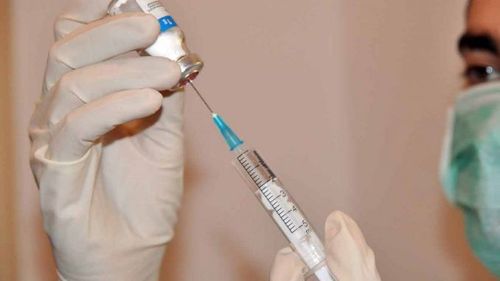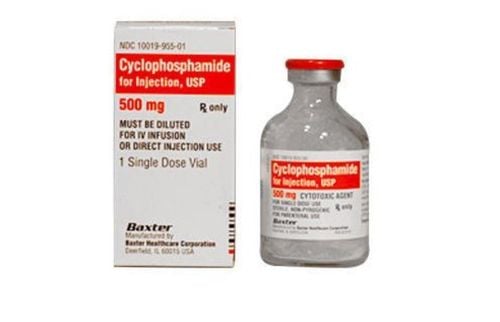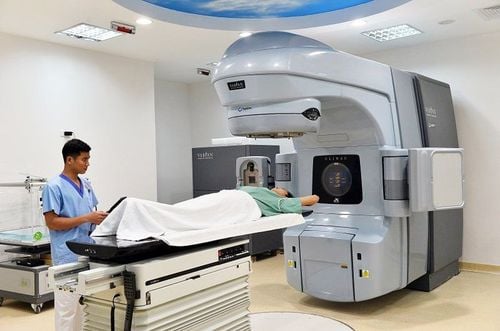This is an automatically translated article.
The most common method used in lung cancer is radiation therapy. This method is used to treat lung cancer in cases where the tumor is large but has not spread to other organs. The duration of lung cancer radiation therapy to prolong the patient's life depends on many factors such as: the type of cancer, the time of detection and treatment, the patient's condition, the health care regimen and nutrition, and the patient's condition. ...
1. What is radiation therapy?
Radiation therapy is the use of high-energy beam projectors (X-rays, gamma rays, protons,...) to help kill cancer cells, destroy tumors, and slow tumor growth. For patients with stage III lung cancer, who are not indicated for surgery, chemotherapy and radiation therapy can be given simultaneously or sequentially to obtain the best curative effect.
Depending on the stage of the lung cancer and other factors, radiation therapy may be used as follows:
As the main treatment (sometimes along with chemotherapy), especially if the lung tumor cannot be removed because of its size or location, if a person is not healthy enough for surgery, or if a person does not want surgery. After surgery (or along with chemotherapy) to try to destroy any small areas of cancer that surgery may have missed. Before surgery (usually along with chemotherapy) to try to shrink a lung tumor to make surgery easier. To treat cancer that has spread to other areas such as the brain or bones. To relieve symptoms of lung cancer such as pain, bleeding, difficulty swallowing, coughing or problems caused by spread to other organs such as the brain.
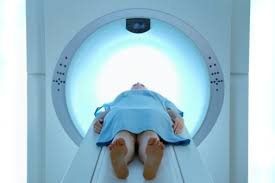
Xạ trị là sử dụng các máy chiếu tia năng lượng cao giúp tiêu diệt tế bào ung thư, phá hủy khối u
2. Types of radiation therapy used for lung cancer
Radiation therapy that can be used to treat lung cancer is of 2 main types:
External beam radiation therapy. Brachytherapy (internal radiation therapy). 2.1 External beam radiation therapy External beam radiation therapy focuses radiation from outside the body at the cancer. This is the most commonly used type of radiation therapy to treat lung cancer or its spread to other organs.
Treatment is like an X-ray, but the radiation dose is stronger. External beam radiation therapy is painless and each treatment only lasts a few minutes. Usually, radiation treatments to the lungs are given 5 days a week for 5 to 7 weeks, but this can vary based on the type of EBRT and the reason it was given.
Newer EBRT techniques have been shown to help doctors treat lung cancer more precisely while reducing radiation exposure to nearby healthy tissue.
Therapies include:
Stereotactic body radiation therapy (SBRT) also known as ablative ablative radiation therapy (SABR): Often used to treat early stage lung cancer when surgery is not needed. an option due to a person's health or in those who do not want surgery. It may also be considered for tumors that have limited spread to other parts of the body, such as the brain or adrenal glands.
Instead of giving a small amount of radiation every day for several weeks, SBRT uses very focused beams of high-dose radiation given in fewer treatments (usually 1 to 5). Several beams are aimed at the tumor from different angles. To precisely target the radiation, you are placed in a specially designed body frame for each treatment. This reduces lung tumor migration during breathing.
Three-dimensional conformal radiation therapy (3D-CRT): Uses special computers to map the exact location of the tumor. The radiation beams are then shaped and targeted at the tumor(s) from multiple directions, making it less likely to damage normal tissue.
Intensity modulated radiation therapy (IMRT): Is a form of 3D therapy. Along with shaping the beams and aiming them at the tumor from multiple angles, the beam's power can be adjusted to limit the dose reaching nearby normal tissues. This technique is used most often if the tumor is near important structures such as the spinal cord.
A variation of IMRT is called volume-modulated arc therapy (VMAT). It uses a machine that delivers radiation rapidly as it rotates once around the body. This allows each treatment to be given in just minutes.
Stereotactic radiosurgery (SRS) Not really surgery, but it is a type of stereotactic radiation that is given in one go. It may sometimes be used instead of or along with surgery for single tumors that have spread to the brain.
In one version of this treatment, a machine focuses about 200 beams of radiation at the tumor from different angles for minutes to hours. Your head is held in the same position as a rigid frame.
In another version, a computer-controlled linear accelerator (machine that generates radiation) moves around your head to deliver radiation to the tumor from various angles. These treatments can be repeated if needed.
2.2 Brachytherapy (internal radiation therapy) In people with lung cancer, brachytherapy is sometimes used to shrink tumors in the airways to relieve symptoms.
The doctor places a small source of radioactive material (usually in the form of small pellets) directly into the cancer or into the airway next to the cancer. This is usually done through a bronchoscope, but it can also be done during surgery.
Radiation travels only a short distance from the source, with limited effect on surrounding healthy tissue. The radiation source is usually removed after a short time. Less often, small radioactive seeds are permanently left in place and the radiation becomes weaker over several weeks.
3. Side effects of lung cancer treatment with radiation therapy

Mệt mỏi, buồn nôn là những tác dụng phụ có thể xảy ra sau khi xạ trị
If the patient is about to have radiation therapy, the doctor will talk about the possible side effects so that the patient knows what to expect, reducing anxiety for the patient. Common side effects depend on where the radiation is aimed and can include:
Fatigue. Nausea and vomiting. Loss of appetite and weight loss. Skin changes in the area being treated, which can range from mild redness to blistering and peeling. Hair loss where radiation enters the body. Often these go away after treatment. When radiation is given with chemotherapy, side effects may be worse.
Radiation therapy to the chest can damage the patient's lungs and cause coughing and difficulty breathing. They usually improve after treatment ends, although sometimes they may not go away completely.
The patient's esophagus in the center of the chest may be exposed to radiation, causing sore throat and difficulty swallowing during treatment. This can make it difficult for the patient to eat anything but soft foods or liquids for a while. This also usually improves after treatment ends.
Radiation therapy to large areas of the brain can sometimes cause memory loss, headaches, or trouble thinking. Usually these symptoms are minor compared to those caused by cancer that has spread to the brain, but they can affect a patient's quality of life.
4. Lung cancer radiation treatment time
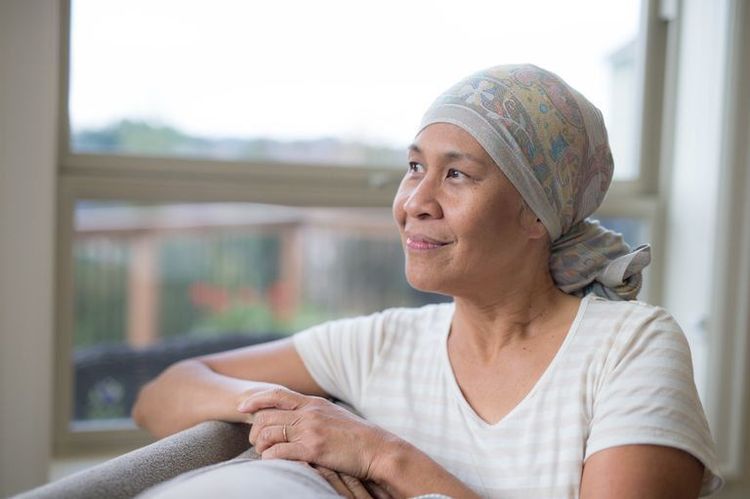
Thời gian trị liệu phụ thuộc vào loại ung thư, thể trạng bệnh nhân
Usually the patient will have radiation therapy once a day, and radiation therapy from Monday to Friday.
The duration of therapy depends on the type of cancer, the patient's condition, the time of diagnosis and the care regimen. , nutrition,...
With an effort to accompany Vietnamese cancer patients, Oncology Center - Vinmec Central Park International General Hospital is modernly built according to international standards, using the model multi-specialty approach in diagnosis, selection of appropriate treatment regimens for each patient, contributing to comprehensive patient care.
Vinmec Central Park Cancer Center has outstanding advantages in cancer treatment such as:
Gathering leading experts in radiation therapy, chemotherapy and surgery. The treatment process is closely coordinated with many specialties: Center for Diagnostic Imaging, Laboratory Testing, Cardiology, Department of Obstetrics and Gynecology, Department of Endocrinology, Department of Rehabilitation, Department of Psychology, Department of Nutrition Nursing, Pain Treatment and Palliative Care Department, in order to provide patients with the optimal treatment regimen and the most reasonable cost. Modern facilities with outpatient clinic of international 5-star standard; 16-bed boarding area of international 5-star standard; day treatment area for chemotherapy patients with comfortable facilities; especially in the radiotherapy area, there is the most modern Truebeam radiotherapy machine in Southeast Asia. As the first hospital in Ho Chi Minh City to apply autologous immunotherapy, Vinmec Central Park Hospital can treat cancer with multimodal cancer treatment regimens tailored to each case, bringing effective results. high treatment results, providing 1 more reliable cancer examination and treatment address for people in Ho Chi Minh City and surrounding areas, so that people do not have to go abroad for treatment
Please dial HOTLINE for more information or register for an appointment HERE. Download MyVinmec app to make appointments faster and to manage your bookings easily.
References: cancer.org




